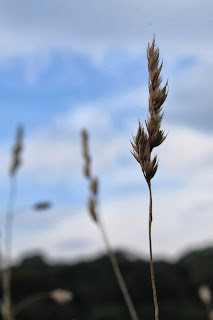Long Exposures
Whilst at Dolphinholme, I decided to work with long exposures, shooting running water. At first I found it difficult because I wasn't using a tripod, which made a lot of blurry photographs. These pictures exhibit camera shake, they aren't out of focus, that is a different look entirely.
Because of the blurriness created from the long exposure, I started using surrounding rocks and trees to balance the camera on. Whilst solving the issue of camera shake, it posed the problem of composition. I didn't have the freedom to move around and get close in, I was relying on improvisation, which made getting my intended outcome difficult.
Clearly, the surrounding are interfering with the shot, showing that it was an impractical way of working. From this point, I used a tripod, allowing me to get much closer to the water aswell as get much better composure within the frame.
I was able to create both close up and wide photographs due to the freedom the tripod gave me. I used this to my advantage to make a range of photographs, the two above are examples of what I produced. The long exposures (around 5 seconds) allow the sensor to capture every movement in the water, making is appear like a liquid smoke when exposed. This required a low ISO (exposure sensitivity - 100ISO) and a range of apertures depending on the sunlight at the time (between f6 and f16).
From the two photographs, I created the two below. These were done by desaturating the image digitally, then adding a vignette to frame the photograph. Although I have received mixed feedback, both negative and positive, I think the desaturated look is very fitting, it gives off an eery effect.
The photograph below is probably the best example of the work I produced, the water fills the frame, really drawing attention to the subject. Although I like the wider angled photograph, I think the close up is more obvious, the subject is clear straight away. Also, because it was a point in which the water had the most movement, the smoke effect is a lot more intense and clear.
Plants
After photographing using long exposures, I started shooting plants. I initially shot from a low angle, upwards to capture a lot of sky in the frame, creating almost a silhouette. The day was relatively clear, so there was a real distinction between the greens and yellows of the plants, and the blues of the sky. I used a very shallow depth of field to draw focus to specific subjects. It was quite difficult to photograph, because the plants were so small, and it was windy outside.
I then moved onto photographing with long exposures again, and burying the camera in grass and plants. There wasn't a great enough range of colours to make an interesting photograph in my opinion, the outcomes weren't very visually exciting.
This is not a technique I would use again, unless I had a much wider range of colours. I think the green and pale browns/yellows are the downfall of these photographs; the colours are very boring. If I was to do something similar again, I would go for an approach more like this
The range of colours make the photograph much more appealing, in my opinion. Although the photographs are shot in completely different ways in terms of lighting and composition, the technique can be carried across to make a similar style of work.
Here is a couple more photographs which I have edited through Adobe Photoshop. These were part of the set of plants I photographed, focussing on a small subject with a shallow depth of field. I think these photographs have turned out well, both original and edited.
I thought the black and white and sepia tone made the photographs bolder and more appealing. The black and white photograph for example, draws more focus to the subject because of how contrasty and bold it is compared to the pale grey background. Also, the sepia tones leaves look almost golden in the water, again drawing attention to them.




















No comments:
Post a Comment